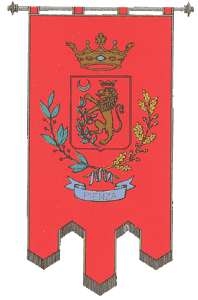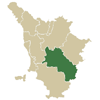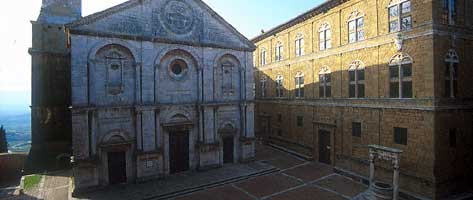|  Inhabitants in 1991: 2.330
Inhabitants in 1991: 2.330
 The
municipal territory of Pienza extends for 122,53 square kilometres on
the hills of the Val d’Orcia, on two slopes of the valley formed
by the river Tresa. Medieval Podesta office then Vicariate Seat. In 1833
the district of Castelmuzio was detached from it and aggregated to the
community of Trequanda. The
municipal territory of Pienza extends for 122,53 square kilometres on
the hills of the Val d’Orcia, on two slopes of the valley formed
by the river Tresa. Medieval Podesta office then Vicariate Seat. In 1833
the district of Castelmuzio was detached from it and aggregated to the
community of Trequanda.
Pienza arose in the XV century on the place of the ancient castle
of Corsignano. This settlement was recorded from 828 as organised
“Court” property of the Abbey of San Salvatore al Monte
Amiata and this was subsequently confirmed by Imperial certificates
of the X and XI centuries. Between the end of the XII and the start of
the XIII century the dominion of Siena was affirmed over the castle and
the village which had developed around it, given the strategic importance
of the position (and after the war of 1229-1235 when the castle was occupied
by the Fiorentini and the Orvietani) in the middle of the century it was
provided with a military garrison. In the meantime in the territory of
Corsignano, by now become Podesta Seat (1330) and then Vicariate (1348),
the possession of the Piccolomini family was extended and when
in 1458, Enia Silvio Piccolomini, who was born there in 1405,
became Pope with the name of Pio II, a phase of restoration of the
ancient castle was begun; the work was trusted to Rossellino, and
Corsignano changed its name to Pienza, and also received
the name of Episcopal Seat (1462). Pienza preserves quite notable monuments
from its Medieval and Renaissance past, among which the Cathedral, the
parish church of San Vito, and the Palazzo Piccolomini. In the second
half of the 1400s it was claimed to be a vivacious commercial and economic
centre, but from the start of the 1500s it was forced to submit to
a long series of military incursions and devastation, from that by Cesare
Borgia in 1502 until the more grave last phase of the Siena war (1553.1555).
In 1559 Pienza became part of the Mediceo Duchy. The ancient castle
of Monticchiello is also found in its territory, nucleus of great importance
for all the Medieval period, where in April 1944 on the of the most significant
events of the resistance of South Toscana took place: a group of about
70 partisans defeated the Nazifascist occupying forces, availing themselves
of the solid and courageous help of the population.
 Today this "ideal city" lives on tourism, the main attractions being
its geographic position and its architecture.
The pecorino (sheep's cheese) of Pienza is one of the best, and
best-known, in Italy, and here you can sample an excellent fettunta
con pecorino ed olio tartufato - toasted bread with cheese and
oil aromatised with truffles - accompanied by a glass of good local
wine.
Places to visit:
Piazza Pio II, spacious main square of Pienza, on which faces
the Cathedral and the most important buildings, it is embellished
by a Travertino stone Well designed by Rossellino.
Palazzo Piccolomini, erected in 1459 on a project of Rossellino,
as Papal residence. It has an extremely beautiful square courtyard
encircled with a portico on the left of this extends the hanging garden.
In the first half of the 1900s the palace was completely restored.
Palazzo Comunale, placed opposite the Cathedral and adorned
with a portico. Constructed in Travertino stone, it has a crenelated
tower in brickwork.
Corso Rossellino, the most important street in Pienza, it connects
the two major gates of the city. It is flanked by splendid palaces
built as residences for the Papal Court.
Casa dei Canonice, in the Piazza hosts the Cathedral Museum.
The Cathedral, erected in 1460 dedicated to Sant’Andrea
its patron, preserves in the interior the relics of the Saint, sent
on purpose from Rome by Pio II, to enrich his city.
S. Francesco, 1200s Gothic church which preserves interesting
paintings from the 1300s. |
Historical info reproduced upon authorization of
Regione Toscana - Dipartimento della Presidenza E Affari Legislativi e
Giuridici
Translated by Ann Mountford
Picture by Sandro Santioli |